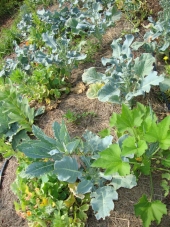









Veronica Shukla, zone 5
www.ProjectFoodForest.org








Come join me at www.peacockorchard.com




Danielle Venegas wrote:So why do you want to define your spaces? Did you not zone it or anything? I have various things in the works and none of them are defined as in edged with brick or anything. They are simply part of my landscape. So I'm wondering what you mean by defined.




Veronica Shukla wrote:I've been taking my project very, very slowly and have been wracking my brain over when to start the big stuff and how fast to go. I'm mostly posting to watch for any advice that comes to you. I want to plant all my trees and shrubs like last year, but alas, I only have so much time and energy and am waiting for the baby to get a little less demanding
 3
3




Kevin Mace wrote:That is good advice. Thanks for replying.
I want to plant everything yesterday and also build a rocket mass heater, greenhouse, cob over, etc.
Veronica Shukla wrote:I've been taking my project very, very slowly and have been wracking my brain over when to start the big stuff and how fast to go. I'm mostly posting to watch for any advice that comes to you. I want to plant all my trees and shrubs like last year, but alas, I only have so much time and energy and am waiting for the baby to get a little less demanding
 I bought 14 acres last year and went hog-wild digging ponds by hand, trenching for drainage (wet property), clearing overgrown brush and planting/transplanting. I must have put in well over 90 hours per week for 8 of the last 12 months, planted well over 500 plants/trees/shrubs and spread something on the order of 150lbs of seed between grasses, flowers, clover, etc. What do I have to show for it? Blisters, callouses, an aching back, maybe a 50% survival rate and less than a 10% germination rate. We did get to eat 3 strawberries, a handful of tomatoes, a few salads and even 2 or 3 blueberries. On the other hand, I've cleared several acres of brush and so prepped planting sites for several years to come, built a 2+ ton rocket mass heater, have 2 hoop-houses with one currently devoted to generating compost, have well over 7,000 gallons of rainwater catchment in the ponds and have increased the diversity of plant species dramatically from what we originally had. Over this last year, its really sunk in how much work all this is!
I bought 14 acres last year and went hog-wild digging ponds by hand, trenching for drainage (wet property), clearing overgrown brush and planting/transplanting. I must have put in well over 90 hours per week for 8 of the last 12 months, planted well over 500 plants/trees/shrubs and spread something on the order of 150lbs of seed between grasses, flowers, clover, etc. What do I have to show for it? Blisters, callouses, an aching back, maybe a 50% survival rate and less than a 10% germination rate. We did get to eat 3 strawberries, a handful of tomatoes, a few salads and even 2 or 3 blueberries. On the other hand, I've cleared several acres of brush and so prepped planting sites for several years to come, built a 2+ ton rocket mass heater, have 2 hoop-houses with one currently devoted to generating compost, have well over 7,000 gallons of rainwater catchment in the ponds and have increased the diversity of plant species dramatically from what we originally had. Over this last year, its really sunk in how much work all this is!
 Good luck
Good luck 2
2




 . Planning may not be its own reward, but it will surely bring rewards that would not be realized without it.
. Planning may not be its own reward, but it will surely bring rewards that would not be realized without it.



| I agree. Here's the link: http://stoves2.com |




